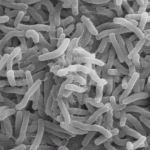Microbiology
|
14 april 2014 19:04:07 |
| Antimicrobial susceptibility pattern of bacterial isolates from wound infection and their sensitivity to alternative topical agents at Jimma University Specialized Hospital, South-West Ethiopia (Annals of Clinical Microbiology and Antimicrobials) |
|
Tweet Background:
Wound infection is one of the health problems that are caused and aggravated by the invasion of pathogenic organisms. Information on local pathogens and sensitivity to antimicrobial agents, and topical agents like acetic acid is crucial for successful treatment of wounds.Objectives: To determine antimicrobial susceptibility pattern of bacterial isolates from wound infection and their sensitivity to alternative topical agents at Jimma University Specialized Hospital.
Methods:
A cross sectional study was conducted among patients with wound infection visiting Jimma University Specialized Hospital, from May to September 2013. Wound swab was collected using sterile cotton swabs and processed for bacterial isolation and susceptibility testing to antimicrobial agents, acetic acid, hydrogen peroxide and dabkin solution following standard bacteriological techniques. Biochemical tests were done to identify the species of the organisms. Sensitivity testing was done using Kirby- Baur disk diffusion method. Minimum inhibitory and bactericidal concentration was done using tube dilution method.
Results:
In this study 145 bacterial isolates were recovered from 150 specimens showing an isolation rate of 87.3%. The predominant bacteria isolated from the infected wounds were Staphylococcus aureus 47(32.4%) followed by Escherichia coli 29(20%), Proteus species 23(16%), Coagulase negative Staphylococci 21(14.5%), Klebsiella pneumoniae 14(10%) and Pseudomonas aeruginosa 11(8%). All isolates showed high frequency of resistance to ampicillin, penicillin, cephalothin and tetracycline. The overall multiple drug resistance patterns were found to be 85%. Acetic acid (0.5%), Dabkin solution (1%) and 3% hydrogen peroxide were bactericidal to all isolated bacteria and lethal effect observed when applied for 10 minutes.
Conclusions:
On in vitro sensitivity testing, ampicillin, penicillin, cephalothin and tetracycline were the least effective. Gentamicin, norfloxacin, ciprofloxacin, vancomycin and amikacin were the most effective antibiotics. Acetic acid (0.5%), dabkin solution (1%) and H2O2 (3%) were bactericidal to all isolates. |
| 80 viewsCategory: Microbiology |
 Characterization of single-stranded DNA-binding proteins from the psychrophilic bacteria Desulfotalea psychrophila, Flavobacterium psychrophilum, Psychrobacter arcticus, Psychrobacter cryohalolentis, Psychromonas ingrahamii, Psychroflexus torquis, and Photobacterium profundum (BMC Microbiology) Characterization of single-stranded DNA-binding proteins from the psychrophilic bacteria Desulfotalea psychrophila, Flavobacterium psychrophilum, Psychrobacter arcticus, Psychrobacter cryohalolentis, Psychromonas ingrahamii, Psychroflexus torquis, and Photobacterium profundum (BMC Microbiology)Characterization of an autotransporter adhesin protein shared by Burkholderia mallei and Burkholderia pseudomallei (BMC Microbiology) 
|
| blog comments powered by Disqus |
MyJournals.org
The latest issues of all your favorite science journals on one page
The latest issues of all your favorite science journals on one page



